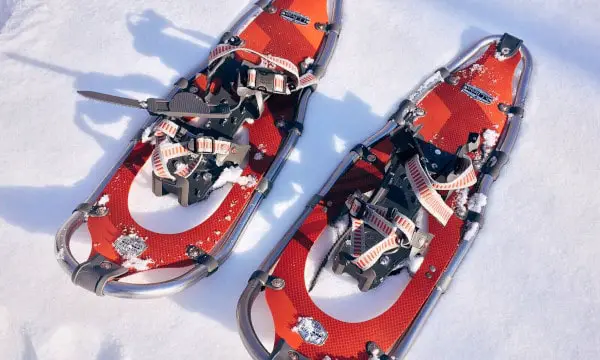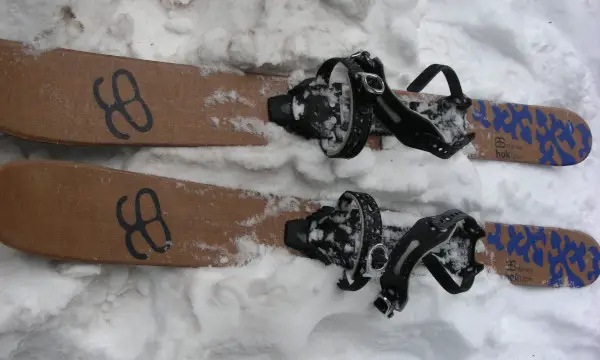Table of Contents
Before you go ahead and get the first pair of snowshoes you see, you should figure out what kind of snowshoeing will you do.
Read on below to know the different types of snowshoes and how to find the one more suited to your needs.
3 Types of Snowshoes
There are three different kinds of adult snowshoes that are differentiated according to the purpose they are used for. These include:
1. Recreational Snowshoes
Recommended for Beginners and Occasional Hikers
Recreational or hiking snowshoes are perfect for a moderate hiking trail and are designed for gently rolling hills and flat terrain. These flat terrain snowshoes are not recommended for steep terrain or going into the backcountry. For moderate slopes, rolling terrain snowshoes are recommended.
When it comes to their build, these snowshoes are shorter than backcountry ones since you do not need a lot of flotation on a relatively flat terrain. Their improved snowshoe traction includes heel lifts, which distinguishes them from many other snowshoes.
2. Running Snowshoes
Recommended for Fitness Lovers
If you love running in the summer and want to continue when winter comes, these running snowshoes are what you need. When it comes to the build, running snowshoes make use of lightweight material and have a trimmed frame that provides you with speed instead of flotation. These racing snowshoes are also ideal for snowshoe racing due to their smaller size and less weight.
It also comes with special traction that keeps you moving, but with these lightweight snowshoes, you cannot run through powdery snow; it is only good for small amounts of fresh snow.
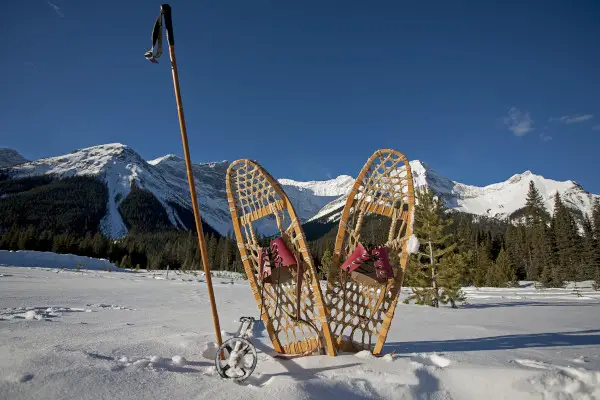
3. Backcountry Snowshoes
Recommended for Adventurers
Backcountry snowshoes are designed for excellent off trail performance and are ideal for climbing either rolling terrain or steep slopes, going out in deep powder snow, and generally spending a longer time on mountain terrain. These mountain terrain snowshoes stay afloat more efficiently and have better traction, which allow them to deal with various different conditions, including steep and icy terrain.
What Size Snowshoe Do I Need?
1. Snowshoe Size Chart
Weight of User + Gear | Snowshoe length for Packed Snow | Snowshoe length for Soft Snow | Snowshoe length for Soft Deep Snow | |
Junior | -50 lb | 17" | 17" | 17" |
Junior | 50-90 lb | 17" | 17" | 19" |
Adult | 80-150 lb | 22" | 22" | 25" |
Adult | 125-189 lb | 22" | 25" | 25" |
Adult | 160-220 lb | 22" | 25-30" | 30" with Tails |
Adult | 200-240 lb | 30" | 30" with Tails | 35" with Tails |
Adult | 240 lb+ | 30-35" | 35" with Tails | 35" with Tails |
*For Soft Deep Snow add flotation tails to the 'Soft Snow' snowshoe size. | ||||
2. Snowshoe Sizing by Snow Conditions
When it comes to snowshoe sizing according to the snow conditions, the key is to get the most fitting length for the type of snow density you are dealing with. You must be able to walk comfortably with the right balance and have good flotation so that you don’t sink in the snow with every step.
Most modern snowshoes range between 22 inches and 36 inches. As a general rule, shorter snowshoes are ideal for snowshoe trails or hiking trails, whereas the longer models are ideal for use in the backcountry and deeper snow.
- As the snowshoe size chart above also shows, packed trails require the least in terms of snowshoe length and surface area. Depending on your loaded weight, you will suffice with shorter snowshoes on a hard packed groomed trail and wet snow.
- Meanwhile, soft snow requires more surface area for the same flotation, thus you will need a longer snowshoe or tails added. Naturally, loaded weight has even more significance on soft snow.
- Finally, deep soft snow requires you to be able to float the same weight with even less dense snow. In most cases, you will require the same amount of length as on soft snow, with additional flotation tails. In certain snow conditions, and with a large loaded weight, you might even need to choose a larger snowshoe for these conditions.
3. Snowshoe Sizing by Weight
The rule of thumb here is that the heavier you are, the larger snowshoe you need. The snowshoe’s surface area is proportional to the weight of the person and his or her pack.
Also, most snowshoes have their maximum load indicated next to its size, so make sure that you calculate your own weight plus the maximum weight your pack might have.
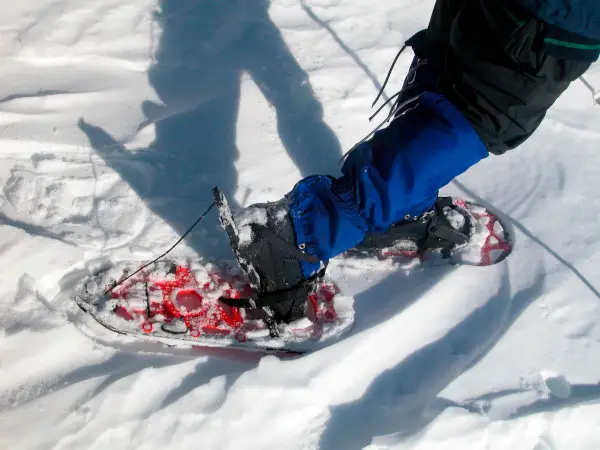
Types of Snowshoe Bindings
As important as the length is, the bindings of your snowshoes also play a very important part. It’s job is to secure your boots to the snowshoe frames and deck. The binding system is linked to comfort and stability. Snowshoe bindings are able to hold any winter boots, hiking boots, but even some mountaineering boots, snowboard boots and most cross-country ski boots will do.
There are three different snowshoe bindings, including:
Multiple Straps Bindings: These are individual straps that secure your foot and go around your heel.
Boa Bindings: This makes use of a wrapped webbing along with wiring that you can tighten via a dial.
Single Pull Bindings: This includes a plastic wraparound that makes it easy to wear and take off with a single pull.
Snowshoe Materials and Weight
When it comes to the weight of the snowshoes, then one thing you should know is that the weight depends entirely on the material. Snowshoes can be made of three different materials for the frame and decking that determine the weight of the snowshoe and how much it can withstand. The top three materials commonly found in modern snowshoes are:
1. Aluminum Snowshoes
Altough some would also opt for wooden snowshoes, traditional aluminum frame shoes are what most people prefer. These traditional snowshoes have a very functional design and a strong frame that protects them from other trail hazards. Aluminum shoes have a decking made from tough nylon, which ensures that you are able to cover long distances comfortably.
2. Plastic Snowshoes
The main advantage of having composite or plastic decking is that it is cheap. It not only costs less than aluminum but also incorporates good traction on the sides. On the other hand, plastic snowshoes have a louder heel impact and they are also more susceptible to damage.
3. EVA Foam Snowshoes
Unlike aluminum frame models or hard plastic, EVA foam snowshoe is made with two layers of foam. They come with a softer compound on top that absorbs shock and a firmer layer present at the bottom that provides you with toughness. It is also good for durability and is ideal for beginners.
Extras
Some other snowshoe accessories and features you need to look out for when you choose snowshoes include the following:
1. Snowshoe Crampons and Side Rails
Excellent traction is what you need when you buy snowshoes, and for this reason, snowshoe manufacturers provide specific features to achieve that traction. These features include toe or instep crampons present underneath the shoes and side rails.
Cheaper snow shoes have small steel toe crampons right under the toes and some extra cleats in the middle, while other types include heel crampons. On the other hand, some shoes have lightweight steel spikes instead of crampons and allow you to walk on the snow casually.
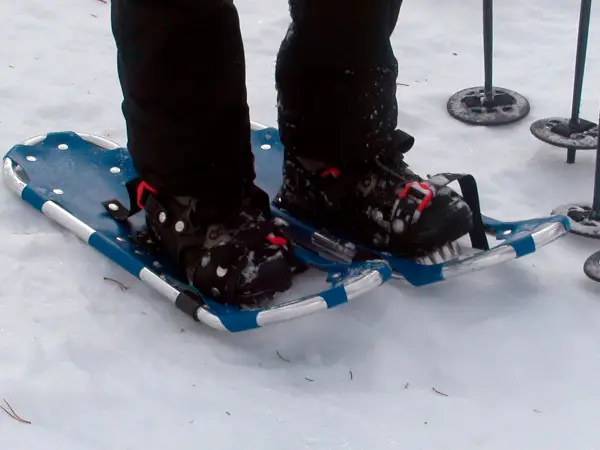
In addition to these crampons, most snowshoes designed for backcountry hiking come with frame rails to add traction on different terrain. These frame rails run along the side of the snowshoes and provide the stability you need when traversing any slope.
When looking for good traction, you need to keep an eye on the depth and material of the traction crampons present; it should be more aggressive for better grip.
2. Flotation Tails
These add-ons are a great way to get all you need in a single pair of snowshoes. You can use these snowshoe tails for better flotation in the soft deep powder, and if you are walking on firm snow, you can take them off.
3. Heel Lift Bars
Most recreational and mountain snowshoes come with heel lifts – also known as climbing bars. These are a single bar of metal under the heel so that it can be raised up and kept in place when climbing. It keeps you from dropping your heel while climbing up and also reduces calf fatigue.
Find the Right Snowshoes for You
Although it might sound unnecessary to get into all that trouble for finding the right snowshoes, but when you are out there in the cold of winter, you always need to consider your safety. Having snowshoes with the right fit and size, as well as matching the conditions out there, it’s not an option but a requirement.
To aid your decision, check out the reviews of our favorite snowshoes this year.

